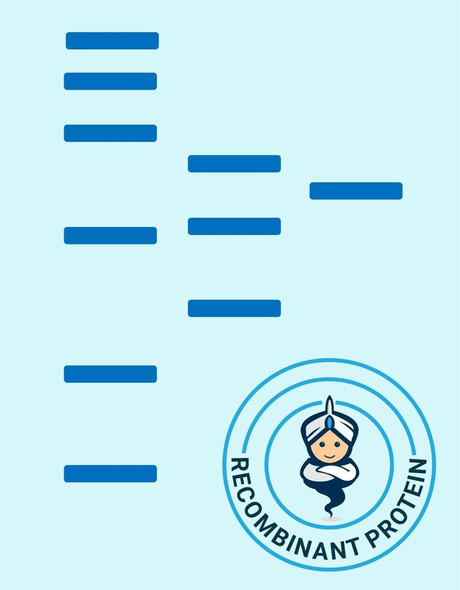Human ST13 Recombinant Protein (RPPB5262)
- SKU:
- RPPB5262
- Product type:
- Recombinant Protein
- Size:
- 50ug
- Species:
- Human
- Target:
- ST13
- Synonyms:
- AAG2
- SNC6
- HSPABP
- FAM10A1
- Source:
- Escherichia Coli
- Uniprot:
- P50502
Description
| Product Name: | Human ST13 Recombinant Protein |
| Product Code: | RPPB5262 |
| Size: | 50µg |
| Species: | Human |
| Target: | ST13 |
| Synonyms: | AAG2, SNC6, HSPABP, FAM10A1, FAM10A4, HSPABP1, ST-13, Hsc70-interacting protein, Suppression of tumorigenicity protein 13, Putative tumor suppressor ST13, Protein FAM10A1, Progesterone receptor-associated p48 protein, Renal carcinoma antigen NY-REN-33, ST13, HIP, HOP, P48, PRO0786, FLJ27260, MGC129952. |
| Source: | Escherichia Coli |
| Physical Appearance: | Sterile filtered colorless solution. |
| Formulation: | The ST13 protein solution contains 20mM Tris-HCl, pH-8, 1mM DTT, 0.1M NaCl & 10% Glycerol. |
| Stability: | Store at 4°C if entire vial will be used within 2-4 weeks. Store, frozen at -20°C for longer periods of time. For long term storage it is recommended to add a carrier protein (0.1% HSA or BSA).Avoid multiple freeze-thaw cycles. |
| Purity: | Greater than 90.0% as determined by SDS-PAGE. |
| Amino Acid Sequence: | MDPRKVNELR AFVKMCKQDP SVLHTEEMRF LREWVESMGG KVPPATQKAK SEENTKEEKP DSKKVEEDLK ADEPSSEESD LEIDKEGVIEPDTDAPQEMG DENAEITEEM MDQANDKKVA AIEALNDGEL QKAIDLFTDA IKLNPRLAIL YAKRASVFVK LQKPNAAIRD CDRAIEINPD SAQPYKWRGK AHRLLGHWEE AAHDLALACK LDYDEDASAM LKEVQPRAQK IAEHRRKYER KREEREIKER IERVKKAREE HERAQREEEARRQSGAQYGS FPGGFPGGMP GNFPGGMPGM GGGMPGMAGM PGLNEILSDP EVLAAMQDPE VMVAFQDVAQ NPANMSKYQS NPKVMNLISK LSAKFGGQA |
ST13 is an adaptor protein (co-chaperone) that mediates the association of HSP70 & HSP90 and appears in early receptor complexes. ST13 plays a role in the assembly process of glucocorticoid receptor, which requires the assistance of multiple molecular chaperones. The expression of ST13 is downregulated in colorectal carcinoma tissue signifying that is candidate tumor suppressor gene. Through common binding to both Hsp70 and Hsp90, ST13 functions as an adaptor that can integrate Hsp70 and Hsp90 interactions. The expression of ST13 decreases in colorectal cancer tissue compared with that in adjacent normal tissue. ST13 is mostly expressed in colorectal epithelia and adenocarcinoma cells. ST13 functions to promote the efficiency of glucocorticoid receptor maturation in cells. The expression levels of the ST13 gene were significantly decreased in primary tumors compared with adjacent mucosa.
Recombinant Human ST13 produced in E.Coli is a single, non-glycosylated polypeptide chain containing 369 amino acids (12-369 a.a.) and having a molecular mass of 41.3kDa.ST13 human recombinant is purified by conventional chromatography techniques.
| UniProt Protein Function: | HIP: One HIP oligomer binds the ATPase domains of at least two HSC70 molecules dependent on activation of the HSC70 ATPase by HSP40. Stabilizes the ADP state of HSC70 that has a high affinity for substrate protein. Through its own chaperone activity, it may contribute to the interaction of HSC70 with various target proteins. Homotetramer. Interacts with HSC70 as well as DNAJ homologs and HSP90. Interacts (via the C-terminus 303- 319 AA) with GRK5. Belongs to the FAM10 family. |
| UniProt Protein Details: | Protein type:Adaptor/scaffold Chromosomal Location of Human Ortholog: 22q13.2 Cellular Component: protein complex; cytoplasm; cytosol Molecular Function:protein binding, bridging; identical protein binding; protein domain specific binding; protein binding; chaperone binding; unfolded protein binding; protein complex binding; dATP binding; Hsp70 protein binding Biological Process: protein folding; protein homooligomerization |
| NCBI Summary: | The protein encoded by this gene is an adaptor protein that mediates the association of the heat shock proteins HSP70 and HSP90. This protein has been shown to be involved in the assembly process of glucocorticoid receptor, which requires the assistance of multiple molecular chaperones. The expression of this gene is reported to be downregulated in colorectal carcinoma tissue suggesting that it is a candidate tumor suppressor gene. Alternative splicing results in multiple transcript variants encoding different isoforms. [provided by RefSeq, Jun 2013] |
| UniProt Code: | P50502 |
| NCBI GenInfo Identifier: | 6686278 |
| NCBI Gene ID: | 6767 |
| NCBI Accession: | P50502.2 |
| UniProt Secondary Accession: | P50502,O14999, Q2TU77, |
| UniProt Related Accession: | P50502 |
| Molecular Weight: | 41,332 Da |
| NCBI Full Name: | Hsc70-interacting protein |
| NCBI Synonym Full Names: | suppression of tumorigenicity 13 (colon carcinoma) (Hsp70 interacting protein) |
| NCBI Official Symbol: | ST13 |
| NCBI Official Synonym Symbols: | HIP; HOP; P48; AAG2; SNC6; HSPABP; FAM10A1; FAM10A4; HSPABP1; PRO0786 |
| NCBI Protein Information: | hsc70-interacting protein; Hsp70-interacting protein; aging-associated protein 2; putative tumor suppressor ST13; renal carcinoma antigen NY-REN-33; heat shock 70kD protein binding protein; suppression of tumorigenicity 13 protein; progesterone receptor-associated p48 protein |
| UniProt Protein Name: | Hsc70-interacting protein |
| UniProt Synonym Protein Names: | Aging-associated protein 2; Progesterone receptor-associated p48 protein; Protein FAM10A1; Putative tumor suppressor ST13; Renal carcinoma antigen NY-REN-33; Suppression of tumorigenicity 13 protein |
| Protein Family: | Hsc70-interacting protein |
| UniProt Gene Name: | ST13 |
| UniProt Entry Name: | F10A1_HUMAN |










